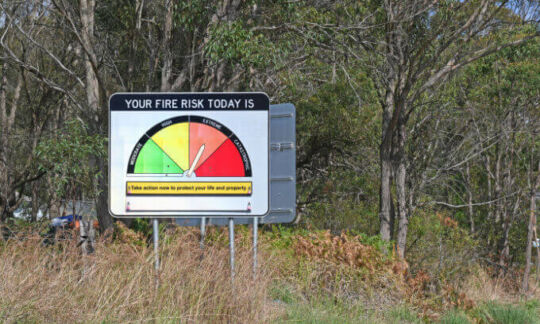Inflation outpacing the cost to replace the family home as bushfire season approaches

With bushfire season the way, Canstar research shows that a concerning number of Aussie households may not be adequately insured for the cost of replacing their homes, should they be destroyed by a fire.
KEY POINTS
-
Canstar’s warning to homeowners this bushfire season is to check your insurance
-
New research shows more than one-third of insured homeowners haven’t updated their sum insured amount in over 12 months, putting them at risk of underinsurance
-
Not all insurers cover homeowners for the full effect of bushfire damage with Canstar explaining what you need to know this summer
Thursday, 07 December 2023 – Bushfire season could be catastrophic for almost two million households who may not have adequate home insurance to cover the cost of replacing their home if it’s destroyed, according to Australia’s biggest financial comparison site, Canstar.
New insights from a Canstar survey of over 1,800 homeowners show of the 87% with home insurance, just over one-third (34%) or the equivalent of 1.82 million of these haven’t updated their sum insured amount in 12 months or more. This is putting them at risk of being underinsured.
The sum insured amount is the maximum amount that the insurance provider will contribute towards the cost of rebuilding a home if it is destroyed, including materials, labour, and replacement fittings and fixtures.
Rising inflation over the past year has pushed up the price of materials and labour with the Australian Bureau of Statistics reporting housing construction costs have risen by 3.9% in the 12 months to September 20233. This could mean inflation has outpaced the cost of replacing the family home.
Canstar’s analysis shows that applying a 3.9% increase in construction costs to a sum insured amount of $450,000 could see homeowners who have not revised this figure fall $17,500 short of the estimated $467,550 needed to rebuild their home if they were to make a claim.
← Mobile/tablet users, scroll sideways to view full table →
|
Potential Sum Insured Increases |
||
|---|---|---|
|
Initial Sum Insured |
Sum Insured if Increases by 3.9% |
Change in Sum Insured |
|
$300,000 |
$311,700 |
+$11,700 |
|
$350,000 |
$363,650 |
+$13,650 |
|
$400,000 |
$415,600 |
+$15,600 |
|
$450,000 |
$467,550 |
+$17,550 |
|
$500,000 |
$519,500 |
+$19,500 |
|
$550,000 |
$571,450 |
+$21,450 |
|
$600,000 |
$623,400 |
+$23,400 |
|
$650,000 |
$675,350 |
+$25,350 |
|
$700,000 |
$727,300 |
+$27,300 |
|
$750,000 |
$779,250 |
+$29,250 |
Source: www.canstar.com.au – 6/12/2023. Increase of 3.9% based on annual change to end of September 2023 in original price index for house construction, per ABS Producer Price Indexes.
Bearing in mind, the latest figures from the Australian Bureau of Statistics in June 2023 put the national average cost of constructing a house at $455,405.
← Mobile/tablet users, scroll sideways to view full table →
|
Average Cost of Constructing a House (June 2023) |
|
|---|---|
|
NSW |
$527,497 |
|
VIC |
$469,040 |
|
QLD |
$381,818 |
|
SA |
$421,049 |
|
WA |
$469,868 |
|
TAS |
$369,852 |
|
NT |
$515,789 |
|
ACT |
$386,280 |
|
National |
$455,405 |
Source: www.canstar.com.au – 7/12/2023. Based on ABS Building Activity, original figures for new houses completed in the June 2023 quarter.
Canstar’s insurance expert, Steve Mickenbecker says, “Beware of your insurance this bushfire season. The last thing homeowners want is to lose their family home in tragic circumstances only to discover at the time of the claim that they don’t have enough cover to replace what was there.”
“Homeowners need to check their policy and make certain they have calculated an accurate sum-insured amount at today’s building prices to avoid being underinsured.
“One-third of Australians who have home and contents insurance have not increased the amount of cover in the past year and with the escalation of building costs could be under-insured by 3.9 percent on average. If they have neglected review of their policy for several years their financial exposure could be catastrophic in the event of total loss of their house.
“Homeowners need to understand their policies at the time they are taking out insurance. This means reading the policy’s fine print which may be painful but it beats having a claim declined. They need to understand what events are covered, what type of damage is insured, the dollar limits paid out for various claims and the exclusions.”
What homeowners need to know about home insurance this summer
Canstar’s research into home and contents insurance policies shows that 100% of the 52 providers and 76 policies available on the comparison site cover homeowners for damage caused by fire.
However, not all home insurance providers cover homeowners for the full effect of bushfire damage. The findings show that less than three-quarters (73%) of providers cover homeowners for damage that is a result of a fire such as heat, ash, soot and smoke when the policyholder’s home or contents have not caught on fire and in some cases, this damage will need to be caused by a burning building within a specified distance of your home.
← Mobile/tablet users, scroll sideways to view full table →
|
Bushfire Cover – Home & Contents Insurance |
||
|---|---|---|
|
|
Damage Caused by Fire |
Damage Caused by Heat, Soot, etc. as a Result of Fire |
|
% of Providers that Cover |
100% |
73% |
|
% of Products that Cover |
100% |
59% |
Source: www.canstar.com.au – 07/12/2023. Based on home & contents insurance policies on Canstar’s database including 76 products from 52 providers.
Mickenbecker explains what homeowners should look out for when it comes to their insurance this summer.
“There are traps that can relate more to bushfire than an urban fire that homeowners should be looking out for,” says Mickenbecker.
“Temporary accommodation in the event of the home being damaged or made uninhabitable is not always covered. There is always a delay in repair or replacement but it can be aggravated after a bushfire or other natural disaster if it results in a shortage of available builders.
“Many policies exclude cover for fire until 48 or 72 hours after the policy issues, so that waiting until bushfire is rolling down the hill is not an option. If switching policies, the new policy should start a few days before the expiry of the existing policy to assure uninterrupted cover.
“While all policies cover fire damage, some do not cover water, smoke or soot damage when not accompanied by actual fire damage to the house. Not all damage in bushfires arises through direct fire to the property, but it can nevertheless be costly to remedy.”
How to make sure you have adequate fire cover
Having sufficient insurance could make a huge financial difference in the recovery process if your home and contents are damaged or destroyed by fire. To help ensure you have adequate fire cover, Canstar says to consider the following:
-
If you have a sum-insured policy, check if the amount covered matches the value of your assets. To help in valuing your home and contents, consider using an online calculator, or contacting a professional valuer for your property or items. You can also complete an inventory of your contents by doing a room-by-room evaluation.
-
Carefully read your policy’s PDS to see what is covered and what exclusions apply. You can also speak to your insurer if there is any part of the policy you don’t understand.
-
If you think you may be living in a bushfire-prone area, check to see what building requirements are needed for your home in the event you need to rebuild and consider factoring in these costs to your policy.
-
Shop around to find a policy that best suits your circumstances.
Home insurance resources for homeowners:
You can compare home insurance policies with Canstar, with 50 providers to choose from.
 24/7 claims
24/7 claims
 Online discount
Online discount
 New for old
New for old
 24/7 claims
24/7 claims
 New for old
New for old
 24/7 claims
24/7 claims
 Online discount
Online discount
 New for old
New for old
 24/7 claims
24/7 claims
 New for old
New for old
Canstar may earn a fee for referrals from its website tables, and from Sponsorship or Promotion of certain products. Fees payable by product providers for referrals and Sponsorship or Promotion may vary between providers, website position, and revenue model. Sponsorship or Promotion fees may be higher than referral fees. Sponsored or Promotion products are clearly disclosed as such on website pages. They may appear in a number of areas of the website such as in comparison tables, on hub pages and in articles. Sponsored or Promotion products may be displayed in a fixed position in a table, regardless of the product’s rating, price or other attributes. The table position of a Sponsored or Promoted product does not indicate any ranking or rating by Canstar. For more information please see How We Get Paid.
Cover image source: Douglas Cliff/Shutterstock.com
This article was reviewed by our Content Lead Ellie McLachlan before it was updated, as part of our fact-checking process.

 24/7 claims
24/7 claims
 New for old
New for old
Try our Home Insurance comparison tool to instantly compare Canstar expert rated options.





